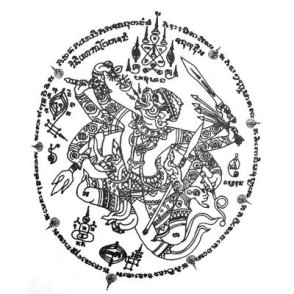Learning Difference – Hanuman and Rahu
Recently I came to discriminate between the very common Hanuman – found virtually everywhere in small statues, huge statues at entrances to temples, on shrines, amulets and tattoos – and the very rarely seen Rahu.
Hanuman 1
Hanuman 2
Rahu (center), eating the sun
You can see the similarity in style between Hanuman and Rahu in their faces and shapes. What can further confuse the two is that Hanuman, when he was young, once mistook the sun for a ripe mango and ran toward it to eat it. Rahu eats the sun as a thing – it’s his thing and is the cause of the eclipse – and Hanuman gets shot down before he gets the chance to realize the sun is not a delicious mango. Hanuman later becomes a pupil of Suriya, the sun, and is revered in Thailand as being invincible, can cause fear in enemies and remove fear from friends, he’s clever and a shape-shifter. You can see why Muay Thai fighters would choose him as a Sak Yant (protective, sacred tattoo). Rahu, however, is a force of Vedic Astrology and has semi-demonic qualities that cause him to be both revered and feared as a bringer of “darkness” – he swallows the sun and moon, after all. But in Thailand (both Hanuman and Rahu come from Hindu tradition) he can also be auspicious in that he also eats darkness and bad luck, so the way to ward off the bad luck that Rahu brings when he’s trying to eat the sun or moon, you can either try to scare him off (light fireworks, make loud noises) or you can placate him (he prefers black offerings, like black grapes, black jelly, black coffee, black beans, etc.) He’s generally the master of somewhat nefarious occupations: pimps, cheaters, deceivers, drug dealers, anyone dealing in immoral acts… bad mojo, basically. But government officials and white collar types will give offerings to Rahu and pray to him in order to get on his “good side” and ward off the negativity of persons who might be in the aforementioned group of backstabbers and saboteurs.
Very interestingly, Rahu is slightly esoteric and belief, familiarity and association with him is concentrated in the north and northeast of Thailand – although the biggest statue of him is in a temple down near Bangkok. But my point is that well-meaning folks up here will use Hanuman as a kind of buffer or counter-balance when dealing with Rahu, kind of as protection. This is because of the Hanuman/Rahu run in with the mango that was actually the sun. So the conflation of the two in my mind before I knew the difference is somewhat interesting in that context. More generally a good counter to Rahu is Genesha, who is very commonly honored in Thailand by students and business people who are beginning new ventures or taking exams, as Genesha is the “placer and remover of obstacles.” This is mirrored somewhat in the way that Rahu brings and also eats negativity and darkness.
Finding Rahu
On the desk in our apartment we have a statuette of Ganesha, who holds his broken tusk in one hand. I love this about him – it’s an image that expresses how opportunity come out of accidents. I’ve asked him to remove obstacles in my progress as a fighter, most of which are beliefs in my head that hold me back. After learning about Rahu, we decided we want a statue of him as well – a kind of “wading into” process while I consider a Sak Yant tattoo of Rahu. Today we went up to the temple at Doi Suthep, which has a large market at the bottom of its very long and famous Naga stairs that offers a great number of small statues, singing bowls, bells, etc. Each “store” bleeds into the next and there’s very little variation in wares between each seller. So you just pick a spot and start looking, moving around and between the women who love a good haggle (I cannot haggle; I’d rather have my teeth removed).
I asked the first woman in Thai if she had Rahu. She didn’t understand me at first and then finally repeated the name back to me in proper pronunciation and began looking through her stock. (It’s La-WHO?? with the second syllable rising as if the speaker is incredulously asking “who?”) She found one very, very tiny Rahu, smaller than a marble and shaped out of what I can only guess is bronze – it’s heavy and solid, a goldish color. Evidently Rahu is far more often an amulet or on a cloth that one hangs than an actual statuette of size. I bought that little one and I love him. There’s no way to suspend the ball by itself and it’s not flat on the bottom to stand, so I reckon there are clear plastic pendants that one purchases in order to wear these things as a necklace. Free-standing amulets are sold all over the place.
A few different shops had the same single selection of a Rahu figure, about the size of an engagement-ring box (when it’s open) and cast in cement, then covered in silver and gold colored metals. He’s always depicted as he is eating a globe, the sun, and so the scale of his head and hands to the sphere and the voraciousness of his expression is very important to me in whether or not I’m drawn to the image. Every shop only had one, all the same. He’s not very popular and for whatever reason this shape just wasn’t expressing him for me or to me. Finally we found one alternate version, about the size of a tennis ball and spherical, his body wrapped around the globe as he devours it. It’s covered in silver and gold colored metals like the others, but his face is amazing. When we had purchased him we climbed up the stairs to the actual temple and I held him in my hands, the base of him cradled in my left hand and my right hand cupped over the top. The weight felt so nice that I had Kevin carry him like this to try it out. Now he’s on our desk next to Ganesha with a bowl of black coffee beans for him. (Black beans promote progress.)
We’ve been reading a lot about Rahu over the past few days and he just becomes more interesting. I must admit I don’t buy into synchronicity and absolutely believe there are coincidences that don’t carry advanced meaning; however, the ways in which Rahu has been revolving through my life in the past few days is pretty extraordinary.
Thai Epic – Khun Chang Khun Phaen
In our research into Rahu we followed the references to discover (or re-discover, for me) a Thai epic that is arguably the Thai epic, called “Khun Chang Khun Phaen.” It’s a love story between one woman and two men, an ugly high-rank and a handsome peasant, between whom she cannot seem to choose. That ends up costing her her life – the king sentences her to death for failing to choose! – and in contrast to the three days that is Romeo and Juliet, this love triangle spans over 50 years, a couple wars, etc.
I first came across this title from my Thai language teacher. He told me we would read it eventually, as everyone in Thailand reads it – kids learn passages, it’s integrated into songs, stories, soap operas, etc – and the scenarios and characters are universally recognized. Khun Phaen, the handsome peasant who is also a warrior (probably badass in Muay Thai), is the term for a great lover, like Don Juan or Cassanova. He’s also a sorcerer in black magic. So I’m going to be starting this epic on my own, hopefully with some help from my teacher to put the meter and some of the language and references into context. But it’s delving into a part of Thai culture that is inaccessible in a lot of ways – there’s only one English translation and that only came about in 2010! Because it’s so universally recognized and a part of Thai education and cultural reference, I reckon there’s going to be a lot to glean from a 1000+ page Thai epic. I bought two copies. One is what kids read in school, it’s illustrated like a comic book and has Cliff’s Notes type “cast of characters” in the front pages. That will help me to digest the second copy which is the unabridged text, written in two columns on each page, in proper verse. I’m excited.




























